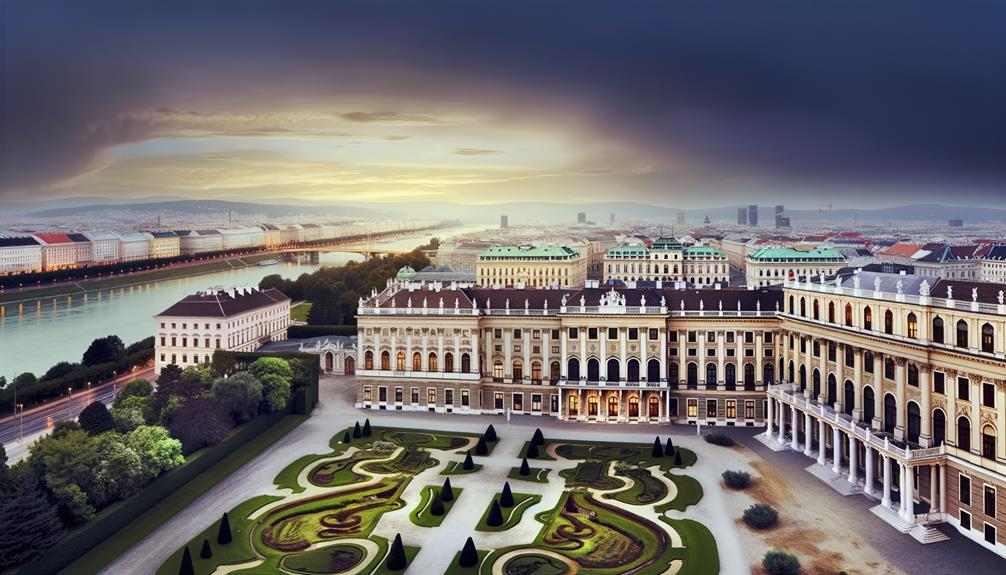Meaning of the Name Vienna
The name 'Vienna' derives from the ancient Celtic settlement 'Vindobona,' translating to 'white base' or 'fair village.' The term combines Celtic 'windo' (white) and 'bona' (base). Vienna's historical roots also encompass its significance during the Roman era as a military outpost along the Danube River.
The name evolved linguistically through Latin and Germanic influences, reflecting a rich cultural tapestry. Medieval and modern adaptations enriched its etymological journey.
Vienna's name reflects a profound historical and linguistic heritage interwoven with its Celtic and Roman past. Explore further to discover the layers of its unique cultural significance.

Key Takeaways
- The name 'Vienna' originates from the Celtic word 'Vindobona,' meaning 'white base' or 'fair village.'
- 'Vindobona' reflects the ancient Celtic influences and roots of the city.
- Vienna's name evolved through linguistic adaptations from Celtic and Roman influences.
- The city's name signifies its strategic location and historical significance along the Danube River.
- Modern interpretations of Vienna's name blend historical context with contemporary cultural expressions.
Etymology of Vienna
The etymology of Vienna traces back to its ancient roots, with the city's name believed to originate from the Celtic word 'Vindobona,' which means 'white base' or 'fair village.' This nomenclature reflects the linguistic and cultural influences of the Celtic tribes that once inhabited the region.
Linguistically, 'Vindobona' is a compound word: 'vindo' translates to 'white' or 'fair,' and 'bona' translates to 'base' or 'fortified settlement.' This etymological foundation underscores the strategic and geographic significance of the area.
Over centuries, the name evolved through various linguistic adaptations, adjusting to Latin, Germanic, and other local dialects. Consequently, understanding the name 'Vienna' offers insight into the city's rich historical and cultural evolution. Exploring the meaning of the name Vienna reveals connections to the region’s ancient roots and the significant role it played in European history. As the city transformed over time, so did its identity, melding influences from different cultures and eras. This layered history not only shapes the modern city but also enriches the narrative of its name, encapsulating its essence as a crossroads of civilizations.
Ancient Origins
The name Vienna finds its ancient origins deeply embedded in the confluence of Roman and Celtic influences.
Historically, the area was known as Vindobona during the Roman era, a name derived from the Celtic word 'windo-' meaning 'white' or 'fair.'
This linguistic amalgamation underscores the city's significance as a cultural and strategic hub in antiquity.
Roman Era Significance
Amidst its ancient origins, Vienna's significance during the Roman era is underscored by its development as an essential military and administrative hub named Vindobona. Strategically located along the Danube River, Vindobona served as a bastion against Germanic tribes and a critical point for trade and governance within the Roman Empire.
The name Vindobona is believed to be derived from Celtic roots, indicating a pre-Roman settlement that the Romans fortified and expanded. This transformation illustrates Vienna's early importance in regional defense and logistics.
Linguistically, 'Vindobona' combines the Celtic 'windo' (white or fair) and 'bona' (base or fort), reflecting both the locale's geographical and strategic features. Consequently, Vienna's Roman legacy is etched into its historical and linguistic fabric.
Celtic Roots Influence
Vienna's ancient origins are deeply intertwined with its Celtic roots, which significantly impacted the region's early cultural and linguistic development. The name 'Vienna' is believed to stem from the Celtic term 'Vedunia,' signifying 'woodland watercourse.' This etymology highlights the Celts' close bond with nature and their surroundings.
Historical evidence indicates that the area was a notable Celtic settlement prior to Roman rule, known for its advanced skills and commerce. The linguistic shift from Celtic 'Vedunia' to Latin 'Vindobona' during the Roman period further demonstrates the assimilation and progress of cultural influences.
This Celtic legacy established fundamental aspects of Vienna's identity, molding its initial societal structures, language, and customs that persist throughout the city's historical account.
Roman Influence
Frequently disregarded in contemporary discussions, the Roman impact on Vienna's name unveils significant insights into the city's early history and linguistic development.
The Romans established a military camp known as 'Vindobona' around the 1st century AD, strategically positioned to safeguard the empire's northern frontier. Linguistically, 'Vindobona' is derived from the Celtic roots 'windo' (white or fair) and 'bona' (base or fort), reflecting a fusion of local and Roman influences.
This nomenclature underscores the Roman practice of assimilating and Latinizing indigenous names, thereby solidifying their cultural and administrative control. The shift from 'Vindobona' to 'Vienna' illuminates the evolving phonetic and orthographic practices that shaped the city's identity over centuries, laying foundational elements for its modern designation.
Medieval Developments
As the Roman influence waned, the medieval era heralded a new phase in Vienna's linguistic and cultural evolution, marked by the city's integration into the Holy Roman Empire and the gradual Germanization of its name and identity. During this period, Vienna shifted from its Roman roots, known as Vindobona, to adopting a more Germanic nomenclature.
The influence of Germanic tribes and the Frankish empire played a significant role in this transformation. By the 12th century, the name 'Wien' began to appear in historical documents, reflective of the city's evolving identity. This shift was not merely nominal but also indicative of the growing political and economic significance of Vienna within the Holy Roman Empire, further solidifying its central role in European history.
Linguistic Evolution
Tracing the linguistic evolution of Vienna involves delving into the etymological roots of its name, revealing a complex interplay of Latin, Germanic, and Slavic influences over several centuries. The city's name is believed to have originated from the Roman settlement of *Vindobona*, a term rooted in Celtic language, signifying 'white base' or 'fair village.'
Key linguistic milestones include:
- Latin Influence: The Roman designation *Vindobona* during the empire era.
- Germanic Adaptation: Shift to *Wenia* or *Wien* with the migration and settlement of Germanic tribes.
- Slavic Contributions: Possible modifications and phonetic influences during periods of Slavic settlement.
This intricate linguistic tapestry underscores Vienna's rich historical and cultural evolution, shaping its identity over time.
Cultural Significance
The cultural significance of Vienna extends beyond its linguistic roots. Encapsulating its historical importance and profound artistic influence, Vienna's heritage is multifaceted.
As the former seat of the Habsburg Empire, Vienna became a nexus of political power and cultural development, shaping European history for centuries.
Additionally, the city's rich tradition in music, art, and philosophy has positioned it as a beacon of cultural sophistication and intellectual pursuit.
Historical Importance
In the annals of European history, Vienna has consistently stood as a beacon of cultural and political significance, its name evoking a rich tapestry of artistic innovation and imperial grandeur.
The city's historical importance is multifaceted, reflecting its strategic location and enduring legacy as the heart of the Habsburg Empire. Vienna's etymology, rooted in the ancient Roman settlement of Vindobona, speaks to its long-standing prominence.
- Imperial Seat: Vienna served as the capital of the Austro-Hungarian Empire, shaping European politics for centuries.
- Cultural Melting Pot: The city has been a nexus of diverse influences, contributing to its unique cultural heritage.
- Intellectual Hub: Vienna fostered significant intellectual movements, influencing philosophy, science, and political thought.
Through each epoch, Vienna has maintained its stature as a linchpin of European civilization.
Artistic Influence
Vienna's historical importance as an imperial seat and intellectual hub seamlessly extends into its profound artistic influence, firmly establishing the city as a cornerstone of cultural significance in Europe.
The city's name, derived from the Celtic word 'Vindobona' meaning 'white settlement,' hints at its ancient roots as a center of civilization.
Vienna has been a crucible for artistic movements, home to luminaries such as Mozart, Beethoven, and Klimt. The Habsburg dynasty's patronage of the arts fostered an environment where Baroque and Rococo styles flourished.
The city's contribution to classical music, fine arts, and architecture is not merely historical but ongoing, with contemporary institutions and festivals perpetuating its rich cultural legacy.
Vienna remains an indelible symbol of artistic excellence.
Symbolism in Art and Music
Amidst the rich cultural tapestry of Vienna, symbolism in art and music serves as a profound conduit for expressing complex historical narratives and emotional depth. The city's artistic expressions often encapsulate layers of meaning, drawn from its storied past and linguistic heritage.
- Art Nouveau Movement: Symbolized a break from historical styles, reflecting Vienna's turn-of-the-century socio-political shifts.
- Beethoven's Symphonies: Embedded with motifs of struggle and triumph, mirroring the tumultuous Napoleonic Wars.
- Gustav Klimt's Paintings: His use of gold leaf and erotic themes signifies both opulence and the human subconscious.
These elements collectively demonstrate how Vienna's symbolic use of art and music continues to resonate, offering insights into its historical and emotional landscapes.
Modern Interpretations
Drawing from its rich heritage of symbolic expression, contemporary Vienna continues to reinterpret its cultural legacy through innovative artistic and musical forms. This modern exploration is evident in the city's thriving avant-garde scene, where traditional motifs are juxtaposed with cutting-edge techniques.
Historically, Vienna's name, originating from the Celtic word 'Vindobona,' meaning 'white settlement,' reflects its ancient roots. Linguistically, it signifies purity and a foundation of cultural richness. Today's artists and musicians leverage this historical context, embedding nuanced layers of meaning in their work. By blending classical influences with modern sensibilities, they create a dynamic cultural dialogue, honoring Vienna's storied past while propelling it into the future.
In this way, Vienna remains a beacon of artistic evolution and cultural synthesis.
Conclusion
The name Vienna juxtaposes its ancient origins with modern interpretations, revealing a rich tapestry of historical, linguistic, and cultural evolution.
From Roman influences to medieval developments, Vienna's etymology encapsulates a dynamic interplay of languages and traditions.
This duality extends into art and music, where Vienna symbolizes both classical grandeur and contemporary innovation.
Therefore, the name Vienna serves as a bridge, connecting a storied past with a vibrant present, reflecting its enduring significance across time and disciplines.






